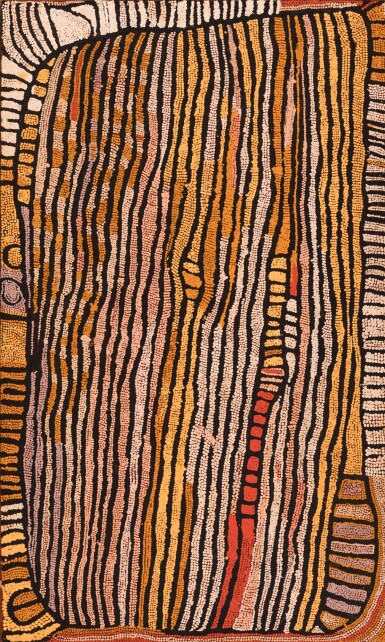
Property from a Distinguished Australian Corporate Collection
Naata Nungurrayi
Untitled
Auction Closed
May 20, 09:03 PM GMT
Estimate
15,000 - 25,000 USD
Lot Details
Description
Naata Nungurrayi
circa 1932 - 2021
Untitled, 1999
Acrylic on linen
Bears Papunya Tula Artists catalogue number NN9904111 on the reverse
60 ¼ in x 35 ⅞ in (153 cm x 91 cm)
Painted for Papunya Tula Artists, Alice Springs in 1999 (catalogue number NN9904111)
Utopia Art, Sydney
Private Collection, New South Wales, acquired from the above
Acquired from the above by the present owner with the assistance of Tim Klingender Fine Arts, Sydney
Naata Nungurrayi had suffered hardships from the time her first husband Pilmatatji Tjangala perished in the extreme drought in the summer of 1961-2. Eventually, Nungurrayi and her young children sought shelter at Papunya in 1964.1 She commenced to paint with the women’s group at Kintore in 1996 when senior ceremonial women at the Pintupi settlement of Walungurra (Kintore, west of Papunya) organised the first of a number of painting camps to which they invited relatives from the Ikuntji Women’s Centre at nearly Haasts Bluff. Away from the gaze of men, the women produced a number of "huge ebullient works alive with (...) ritual excitement and narrative intensity".2 Among these women – the wives, widows, daughters and nieces of the Papunya painters – was Naata Nungurrayi, the sister of George Tjungurrayi.
A feature of the women’s painting camps was their collaboration on large canvases. Naata’s contribution is clearly evident in a painting by Kintore women in 1999, the same year Lot 30 was created, that was shown in the landmark exhibition, Papunya Tula: Genesis and Genius, at the Art Gallery of New South Wales in 2000.3
The palette she developed captures the searing heat of the desert colours in summer, shimmering mirage-like across the canvas. Untitled, 1999, shows Nungurrayi finding her own personal style. The painting relates to a women’s site at the rock hole of Marrapinti where a group of ancestral women made nose bones, also known as marrapinti, worn in the pierced septum during ceremonies.
1 Johnson, V., Lives of the Papunya Tula Artists, IAD Press, Alice Springs, 2008, p.349.
2 Perkins, H. and H. Fink (eds), 2000, Papunya Tula: Genesis and Genius, Art Gallery of New South Wales, Sydney, in association with Papunya Tula Artists, Alice Springs, p.197.
3 Ibid. See another work by Naata Nungurrayi from 1999 in the exhibition on p.145, and the Kintore Women’s Painting on p.159.
You May Also Like










